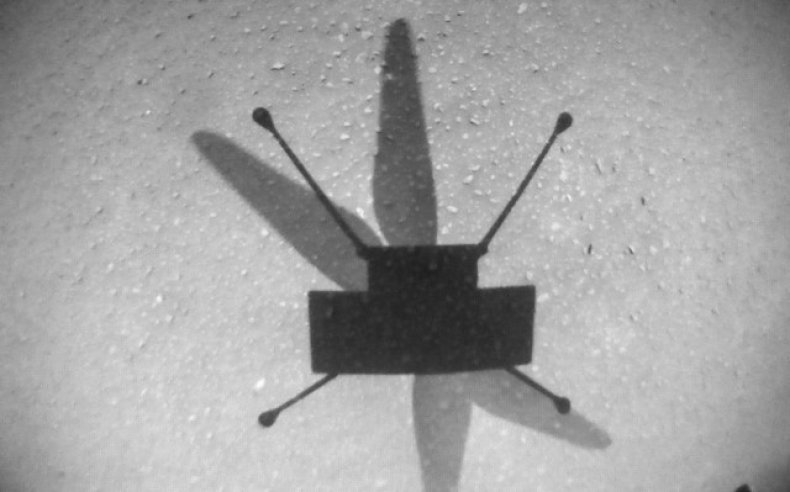Photo Shows NASA's Mars Helicopter Make Its 'Most Challenging' Flight Ever
NASA's Ingenuity helicopter has completed its most treacherous flight on Mars yet, as the space agency pushes its limits further and further.
The little helicopter's ninth flight saw it travel a distance of 2,051 feet. It hit speeds of 16 feet per second in its flight that lasted around 167 seconds.
The flight was expected to be a nail-biting one because NASA was asking the helicopter to do something its flight navigation algorithm had not been designed for—flying over uneven terrain.
However, the flight was successful and Ingenuity was able to capture a photo with its navigation camera mid-flight, seen below.

Ingenuity first flew on April 19 after traveling to the surface of the red planet tucked away inside the Perseverance rover, which itself landed on February 18 this year. The helicopter is the first aircraft ever to fly on Mars.
Before its ninth flight, Ingenuity flew between five different airfields, covered a distance of 873 feet, and hit ground speeds of up to 13 feet per second. It also flew as high as 33 feet.
Despite one in-flight anomaly, NASA engineers say the helicopter has already exceeded their expectations and proved successful.
However, on July 2 NASA described the then-upcoming ninth flight as "the most nerve-wracking flight since flight one."
And in a tweet posted on Monday, the space agency called flight nine the "most challenging flight yet".
#MarsHelicopter pushes its Red Planet limits. 🚁
— NASA JPL (@NASAJPL) July 5, 2021
The rotorcraft completed its 9th and most challenging flight yet, flying for 166.4 seconds at a speed of 5 m/s. Take a look at this shot of Ingenuity’s shadow captured with its navigation camera. https://t.co/TNCdXWcKWE pic.twitter.com/zUIbrr7Qw9
For the flight, the rover was instructed to take a shortcut over an area of challenging terrain known as Séítah, which has sandy ripples, high slopes and undulations.
The problem was that Ingenuity's in-flight computer system was designed to work over simple, flat terrain—the helicopter was only ever meant as a tech demo, after all. NASA expected the slopes and undulations of Séítah to cause Ingenuity to automatically keep changing direction as its computer interpreted the ground as flat.
This could have caused the helicopter to land potentially many tens of feet away from its planned landing site, presenting the risk it could touch down in a more treacherous area than scientists hoped.
NASA also said the flight would "stretch the capabilities of the helicopter's telecom system, which was designed for line-of-sight communication over distances of a few hundred meters."
Despite the elevated mission risk, NASA said it believed Ingenuity was ready for the challenge based on data gathered from flights so far.
It also said the mission "fits perfectly" with Ingenuity's goals of demonstrating the capabilities of an aerial vehicle on Mars—travelling quickly along terrain that would otherwise be inaccessible.

